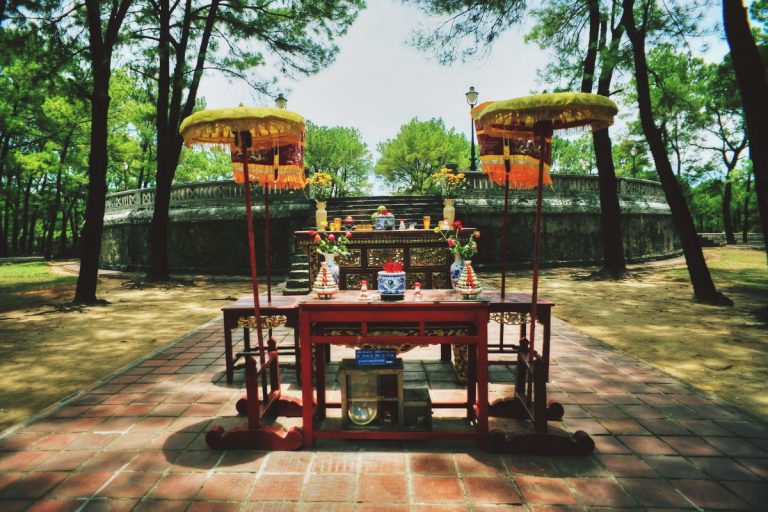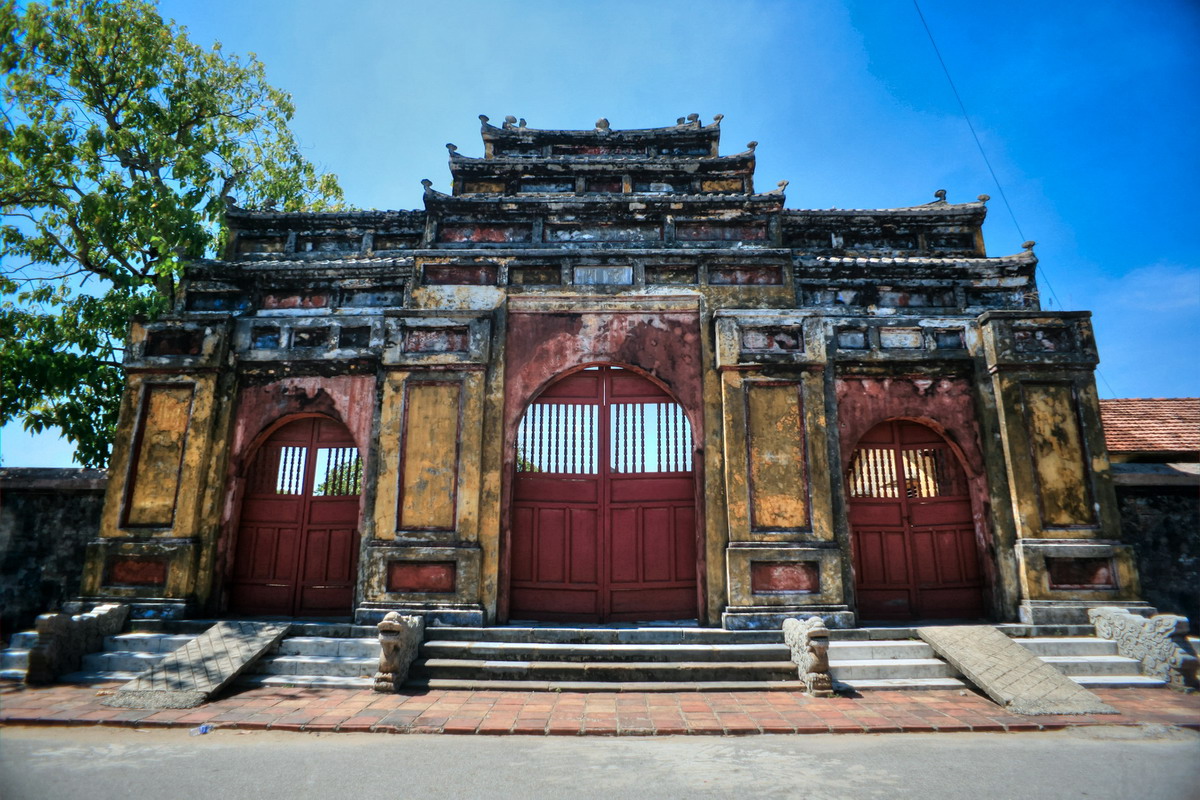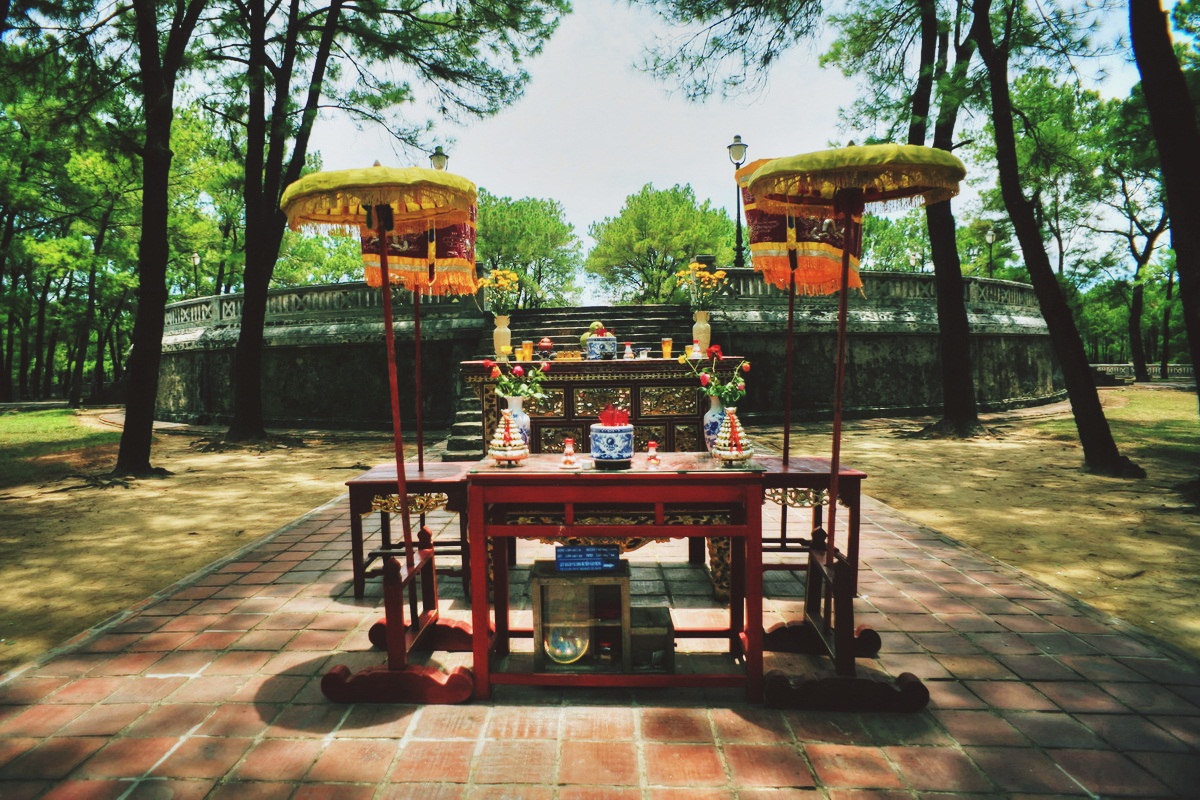In the course of Vietnamese history, there were five dynasties that established the Nam Giao altar to perform rituals of sacrifice to heaven, earth and ancestors. However, up to now, the Nam Giao Altar in Hue Citadel is the only remaining work that is almost intact. This altar was used in the great ceremonies of the Nguyen Dynasty. In 1993, Nam Giao Dandelion was recognized as a World Cultural Heritage by UNESCO.
1. Where is the Where is Nam Giao altar?
- Address: Truong An Ward, Hue City, Thua Thien – Hue Province
- Ticket price: 25,000 VND/pax
Nam Giao Forum (Hue Citadel) was built in Duong Xuan village, south of the citadel. Today, this place belongs to Truong An Ward, Hue City.
The construction was started on March 25, 1806, under the reign of King Gia Long. During the history of the Nguyen Dynasty, 10 of the 13 kings held sacrifices and sacrifices to heaven and earth here. A total of 98 great ceremonies took place by the king himself or by sending people to sacrifice.
Initially the ceremonies were held once a year in the spring and lasted for 3 days. From the reign of King Thanh Thai to 1945, it was extended every 3 years. Under King Bao Dai, the time for the sacrifice was shortened to only one day.
2. Directions to Dan Nam Giao
Located only about 4km from the city center, you can easily move to Dan Nam Giao by many different means.
If you travel by motorbike or car by yourself, you just need to go all the way to Dien Bien Phu. If you go by bus, you can take bus No. 5. This route also has many stops at famous attractions such as Hue Quoc Hoc School, Bao Quoc Pagoda, Nam Giao Temple or Khai Dinh Tomb.
3. Architecture of the Nam Giao Dan
Overview of the architecture of the Nam Giao Dan
Nam Giao Forum was built on a total area of about 10ha. This architectural complex includes the main project Giao Dan and its auxiliary works (such as Trai Cung, Than Tru, Than Kho, …).
The four sides of East, West, South and North of the lute are carved into 4 doors, with the main door being the South door. In front of each of these doors, there is a stone screen, with a width of 12.5m, a height of 3.2m and a thickness of 0.8m. Currently, the work only preserves 3 paintings at the East gate, West gate and South gate.
Surrounding the work is a green pine forest, but over time it has not been intact but has been replaced by some other trees. In the past, the king, prince and great officials all had to plant and take care of their pine trees here. At that time, this tree was a symbol of the generous and brave gentleman.
Giao Dan
Giao Dan is the center of the Nam Giao Dan, and is also the place where the main rituals of the Nam Giao sacrifice ceremony take place. The place is designed with a rectangular campus with an area of 390m x 265m, including 3 floors. The architecture of this category follows the theory of Three Talents in Eastern culture: Heaven – Earth – Human, Heaven is round – Earth is square.
The first floor is called Vien Dan, built in a circular shape, with a green whitewashed balustrade, implying Thien Thanh (Heaven). The second floor is Phuong Dan, square shape, yellow whitewashed railing, symbolizing Dia Hoang (Earth). The last floor is also square, but whitewashed in red, symbolizing Human (human).
Each floor has doors and steps built on all four sides. In which, the East – West – North three levels built 9 levels, and the South built 15 levels. According to historians, the architecture of Dan Nam Giao under the Nguyen Dynasty puts Man on an equal footing with Heaven, Earth and gods. This is also true with the Thai Hoa thought of our country in this era.
Other works in Nam Giao Forum
The palace is the place where the king performed the pure precepts before presiding over the Giao sacrifice ceremony. The bow is built surrounded by a rectangular brick wall, 85m long, 65m wide. The work is located in the southwest of Giao Dan, built in the “north-south” position.
The main gate of Trai Cung is located in the South and has an additional door in the North. The main items in Trai Cung include the Main Palace, Ta Tuc house, Huu Tuc house, Thuong tea room, Thuong Thien department, etc.
In addition, Dan Nam Giao has a number of other typical sub-constructions but today no longer exists. Such as:
- Sacrifice – the place where animals are slaughtered to be sacrificed in the ceremony
- Than Tru – the kitchen to prepare the items used in the ceremony.
- Treasures – warehouse area where sacrifices are stored.
- Along with many temporary works only serving in the sacrifice were erected with wood, thatched roofs, …
4. Historical landmarks of Nam Giao Dan
According to the flow of time, the Nam Giao Dan is associated with important historical milestones. Specifically:
Before 1945
- March 25, 1806, the construction was officially started
- On March 27, 1807, King Gia Long held the first great ceremony to sacrifice Nam Giao Dan.
- During the 79 years of independence of the Nguyen Dynasty, from 1807 to 1885, the Nam Giao sacrifice ceremony was held regularly every spring every year.
- 1886 – 1890 the court stopped the organization of sacrifices
- 1891 – 1945, the ceremony was held again with the time taking place every 3 years.
- March 23, 1945, the day of the last sacrifice ceremony of the Nguyen Dynasty at Dan Nam Giao.
After 1945
- From August 1945, after King Bao Dai officially abdicated, the feudal dynasty of the Nguyen Dynasty ended, the altar was no longer used regularly. After that, it was destroyed by the war, so this work fell into ruin and derelict.
- In 1977, people built a memorial to the martyrs on the foundation of the old Vien Dan.
- In 1992, when the martyrs’ memorial was relocated, the People’s Committee of Thua Thien – Hue province assigned the Hue Monuments Conservation Center to protect and prepare documents for the restoration and restoration of this ancient relic. .
- In 1993, the work was recognized by UNESCO as a World Cultural Heritage and is among 16 monuments of outstanding global value.
- In 1997, Nam Giao Dandelion was officially classified as a national historical-cultural relic and began the process of restoration and embellishment.
- In 2004, at Hue Festival that year, Nam Giao Sacrifice Ceremony was restored at Nam Giao Dan Dan and has become the highlight of this festival until now.
Attractions near Nam Giao Forum
| Sight seeing | Distance (km) |
| Ngu Binh Mountain | 1,7 |
| Tomb of Tu Duc (Khem Lang) | 2,9 |
| Hue capital | 4,2 |
| Trang Tien Bridge | 4,2 |
| Tomb of Khai Dinh (Ung Tomb) | 5,5 |
| Thien Mu Pagoda | 6,6 |
| Minh Mang tomb | 8,2 |
If you have the opportunity to travel to Hue in the near future, do not forget to visit the Nam Giao Temple to learn the most about this important historical site.








Comments